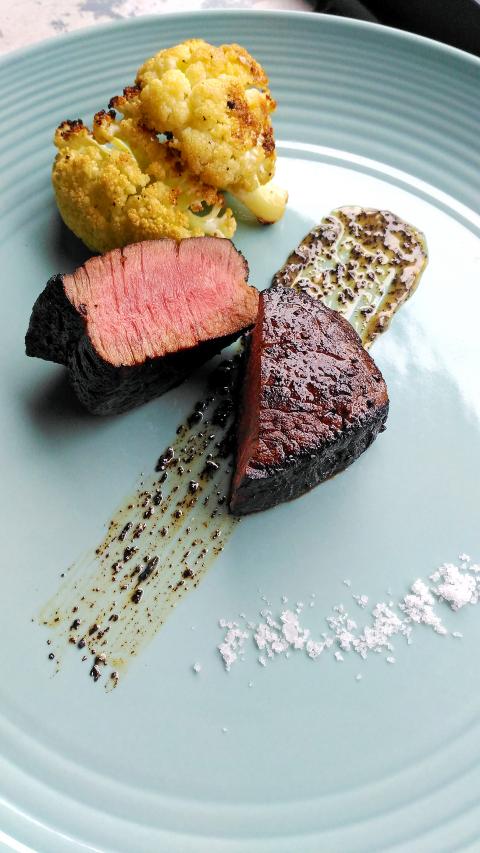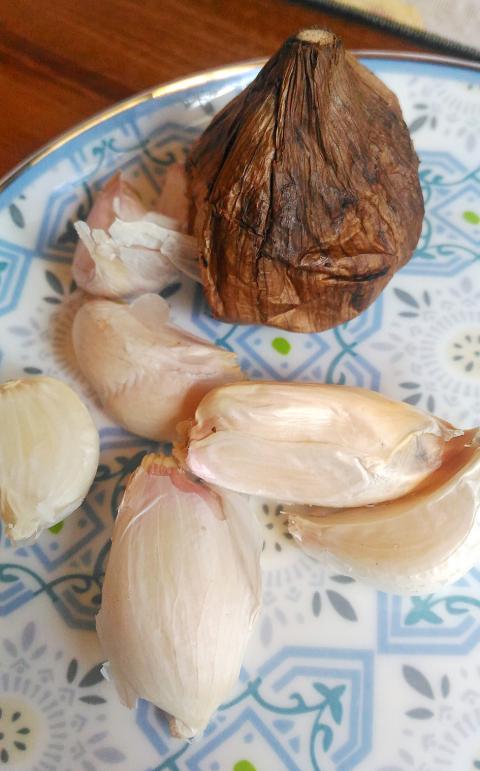Everyone loves garlic, right? Well, some people are not so partial to it. I know and understand this. Sadly, my nine-year-daughter is going through a phase of disliking garlic and it drives me crazy with affronted chef syndrome. Yet garlic is nothing if not endlessly versatile, and recently garlic in a new form has been making its appearance in restaurants and specialist food markets. This is black garlic.
Black garlic has a long history, though there seems to be considerable uncertainty about its actual providence. Many sources suggest that it comes from Korea, which certainly has a long tradition of pickling and fermenting, lending this theory credence.
The smell of garlic frying in olive oil is one of the most awesome smells to grace a kitchen, and this is a gift given to the cook even before the real business of getting lunch on the table begins. Garlic can be used in so many ways and is a foundation of cooking in all the great cuisines of the world. Chinese, French, Italian and Middle Eastern cooks all reach for garlic at the first opportunity. But this is not the case the world over. Anglo Saxons have historically had an aversion to garlic, and prior to the last couple of decades, garlic consumption was often associated sneeringly with southern Europe and Latin cultures. Of course, both these cultural and culinary regions have now risen to worldwide popularity and the sneer has a decidedly grudging quality.

Photo: Ian Bartholomew
My own father, a Briton of the old school, was endlessly fond of regaling family and friends with accounts of his one, not to be repeated, experience with a Greek dentist. In the close quarters of a deep examination of molars, the aromatic intimacy advertised the dentist’s food preferences in a rather too strident manner for comfort. For many non-garlic lovers, this rather imperious disregard for olfactory sensitivities can be a problem. But all is not lost.
Black garlic gets around all these problems, as the bulb develops a completely different flavor through the slow process of curing. It is also said to enhance the already considerable health benefits of regular garlic and offer some of its own unique qualities. Not least, it has greatly enhanced levels of amino acids, that seem to be good for almost every aspect of human health.
Of course, black garlic is quite expensive, reflecting the long and quite complex process of production, but its concentrated flavor allows it to make a huge impact on flavor even when used in relatively small quantities. Many sources refer to black garlic as being fermented, but this is misleading as it is not produced through microbial action but by a slow curing process that requires an extended period, measured in weeks, “cooking” in a temperature and humidity controlled environment. Some sources on the Internet suggest that making black garlic at home is easy, recommending that if you can keep whole heats of fresh garlic at about 60c degrees for four weeks (without it drying out) then you are good to go with a cheap source of black garlic (but this isn’t quite as easy as it sounds and there is a pretty good reason why you can expect to pay around NT$1,000 for five or six heads of good quality black garlic).

Photo: Ian Bartholomew
The blackness is a product of the Maillard reaction, the same process that takes place when we brown meat to draw out the sweetness and flavor. Some people describe black garlic as “caramelized” garlic, and this has appealing suggestions of black garlic’s intense earthy sweetness, with its hints of sauteed mushrooms, dried fruit, rich earth and savory jam.
Black garlic has been around for quite some time on the fringes of herbal medicine, sought after for its concentrated antioxidant effects and other supposed benefits. In the late aughts, it was taken up by a number of high profile chefs and now is beginning to enter the culinary mainstream and is produced around the world. Taiwan produces good quality black garlic, though it is instructive that it still mainly retails as a health supplement. It keeps well in the fridge and so can be kept on hand to give all sorts of dishes a flavor boost.
Beef tenderloin with black garlic butter
Recipe
(serves two)
Garlic can be used in so many ways. From raw garlic to slices gently simmered in olive oil or butter, to garlic pulverized in salt and herbs, it enters everything from salads to stir-fries. This dish uses garlic in a different form, garlic that is treated by long slow cooking until it turns black. The slow process of drying and cooking the garlic at very low heat brings out incredible earthy flavors that at their best rival truffle and other top-end fungi. In Taiwan, I have seen black garlic sold primarily for its health benefits, which are said to be numerous, but that is without doubt only a secondary reason for trying it out. The first is, of course, flavor.
INGREDIENTS
two tenderloin steaks (about 200g each)
salt and pepper to season
olive oil
four cloves black garlic, room temperature
30g butter, room temperature
pinch of sea salt
Directions
1. Trim any remaining tendon and membrane from the tenderloin.
2. Rub generously with salt, pepper and olive oil.
3. Place in a preheated oven at 100c for about 30 minutes or until internal temperature reaches 42c. Turn once.
4. Meanwhile, mash the butter and black garlic together adding salt to taste. A little olive oil can be added to the mix to smooth it out, though this is strictly optional.
5. Heat a stainless steel or cast iron skillet until almost smoking then place the steaks on the hot surface to sear for two minutes each side. Bring internal temperature to about 52c to 56c depending on how you like your meat cooked.
6. Rest the beef for at least five minutes before serving. Serve with a generous smear of black garlic butter and some course sea salt.
Ian Bartholomew runs Ian’s Table, a small guesthouse in Hualien. He has lived in Taiwan for many years writing about the food scene and has decided that until you look at farming, you know nothing about the food you eat. He can be contacted at Hualien202@gmail.com.

Following the shock complete failure of all the recall votes against Chinese Nationalist Party (KMT) lawmakers on July 26, pan-blue supporters and the Chinese Communist Party (CCP) were giddy with victory. A notable exception was KMT Chairman Eric Chu (朱立倫), who knew better. At a press conference on July 29, he bowed deeply in gratitude to the voters and said the recalls were “not about which party won or lost, but were a great victory for the Taiwanese voters.” The entire recall process was a disaster for both the KMT and the Democratic Progressive Party (DPP). The only bright spot for

Water management is one of the most powerful forces shaping modern Taiwan’s landscapes and politics. Many of Taiwan’s township and county boundaries are defined by watersheds. The current course of the mighty Jhuoshuei River (濁水溪) was largely established by Japanese embankment building during the 1918-1923 period. Taoyuan is dotted with ponds constructed by settlers from China during the Qing period. Countless local civic actions have been driven by opposition to water projects. Last week something like 2,600mm of rain fell on southern Taiwan in seven days, peaking at over 2,800mm in Duona (多納) in Kaohsiung’s Maolin District (茂林), according to

Aug. 11 to Aug. 17 Those who never heard of architect Hsiu Tse-lan (修澤蘭) must have seen her work — on the reverse of the NT$100 bill is the Yangmingshan Zhongshan Hall (陽明山中山樓). Then-president Chiang Kai-shek (蔣介石) reportedly hand-picked her for the job and gave her just 13 months to complete it in time for the centennial of Republic of China founder Sun Yat-sen’s birth on Nov. 12, 1966. Another landmark project is Garden City (花園新城) in New Taipei City’s Sindian District (新店) — Taiwan’s first mountainside planned community, which Hsiu initiated in 1968. She was involved in every stage, from selecting

As last month dawned, the Democratic Progressive Party (DPP) was in a good position. The recall campaigns had strong momentum, polling showed many Chinese Nationalist Party (KMT) lawmakers at risk of recall and even the KMT was bracing for losing seats while facing a tsunami of voter fraud investigations. Polling pointed to some of the recalls being a lock for victory. Though in most districts the majority was against recalling their lawmaker, among voters “definitely” planning to vote, there were double-digit margins in favor of recall in at least five districts, with three districts near or above 20 percent in